Statistical Report: Evaluating Business Data for Management
VerifiedAdded on 2021/02/21
|19
|2579
|147
Report
AI Summary
This report provides a comprehensive analysis of statistical methods applied to management, focusing on the evaluation of economic and business data. It begins with an examination of earnings in both public and private sectors, comparing men and women's incomes across different accounting years. The report utilizes various statistical tools, including mean, median, standard deviation, and interquartile range, to analyze business data. It also explores the application of economic order quantity (EOQ) in business planning, specifically in capacity management and inventory control. Furthermore, the report communicates findings through charts and graphs, illustrating trends and comparisons in earnings and other variables. The conclusion summarizes the key findings and insights derived from the statistical analysis, offering valuable information for management decision-making. The report covers different aspects of business data analysis, demonstrating the practical application of statistical techniques in a management context.
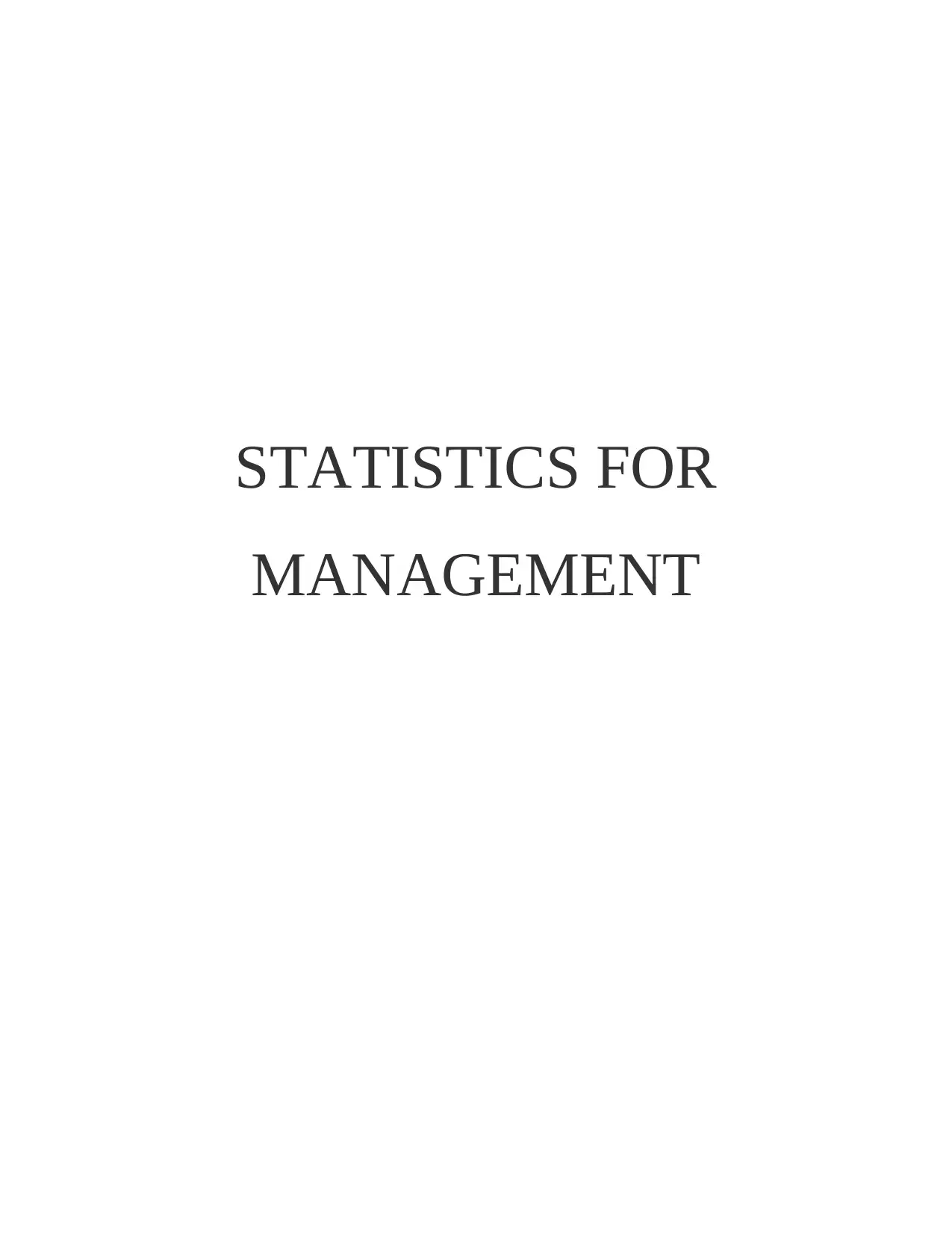
STATISTICS FOR
MANAGEMENT
MANAGEMENT
Paraphrase This Document
Need a fresh take? Get an instant paraphrase of this document with our AI Paraphraser
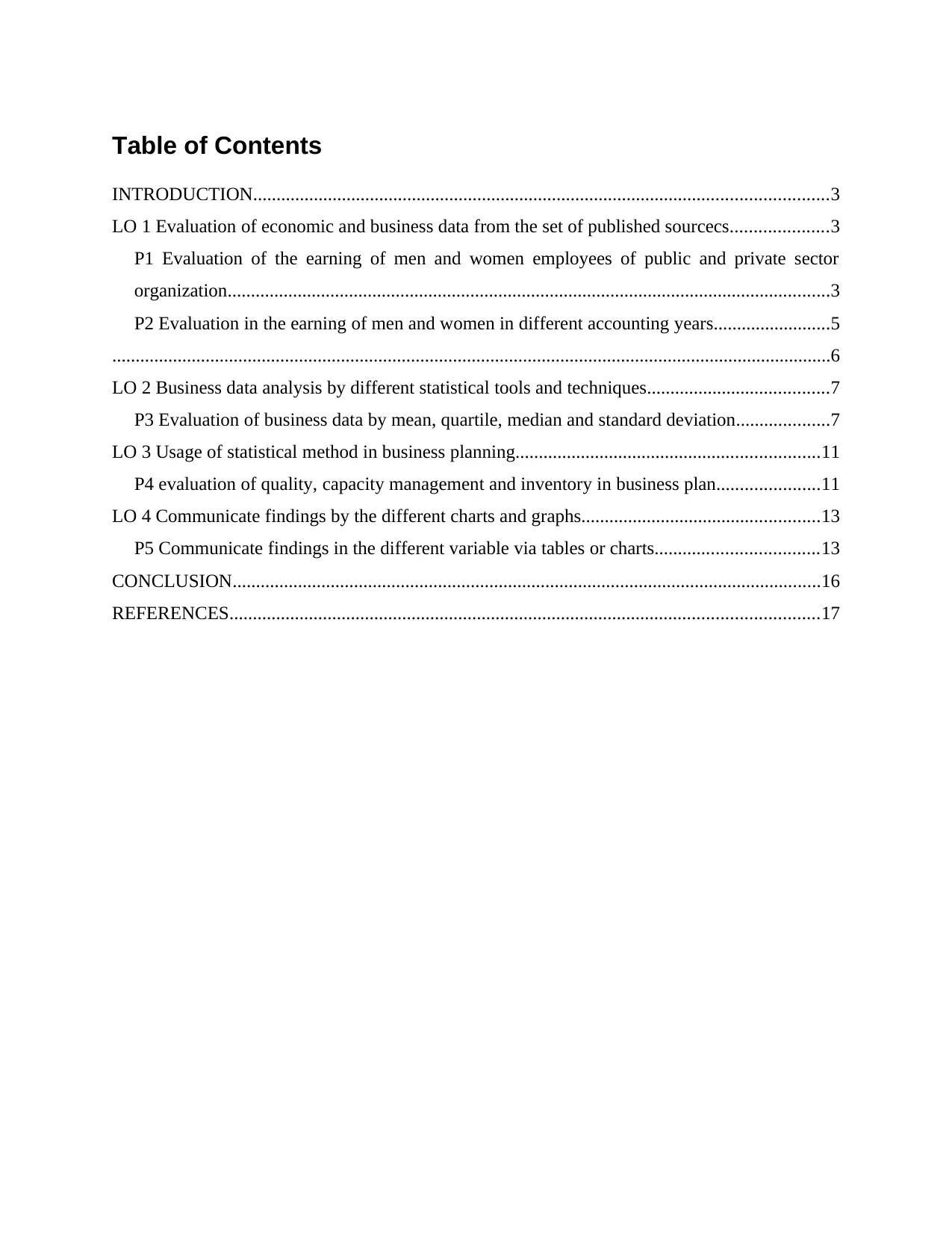
Table of Contents
INTRODUCTION...........................................................................................................................3
LO 1 Evaluation of economic and business data from the set of published sourcecs.....................3
P1 Evaluation of the earning of men and women employees of public and private sector
organization.................................................................................................................................3
P2 Evaluation in the earning of men and women in different accounting years.........................5
..........................................................................................................................................................6
LO 2 Business data analysis by different statistical tools and techniques.......................................7
P3 Evaluation of business data by mean, quartile, median and standard deviation....................7
LO 3 Usage of statistical method in business planning.................................................................11
P4 evaluation of quality, capacity management and inventory in business plan......................11
LO 4 Communicate findings by the different charts and graphs...................................................13
P5 Communicate findings in the different variable via tables or charts...................................13
CONCLUSION..............................................................................................................................16
REFERENCES..............................................................................................................................17
INTRODUCTION...........................................................................................................................3
LO 1 Evaluation of economic and business data from the set of published sourcecs.....................3
P1 Evaluation of the earning of men and women employees of public and private sector
organization.................................................................................................................................3
P2 Evaluation in the earning of men and women in different accounting years.........................5
..........................................................................................................................................................6
LO 2 Business data analysis by different statistical tools and techniques.......................................7
P3 Evaluation of business data by mean, quartile, median and standard deviation....................7
LO 3 Usage of statistical method in business planning.................................................................11
P4 evaluation of quality, capacity management and inventory in business plan......................11
LO 4 Communicate findings by the different charts and graphs...................................................13
P5 Communicate findings in the different variable via tables or charts...................................13
CONCLUSION..............................................................................................................................16
REFERENCES..............................................................................................................................17
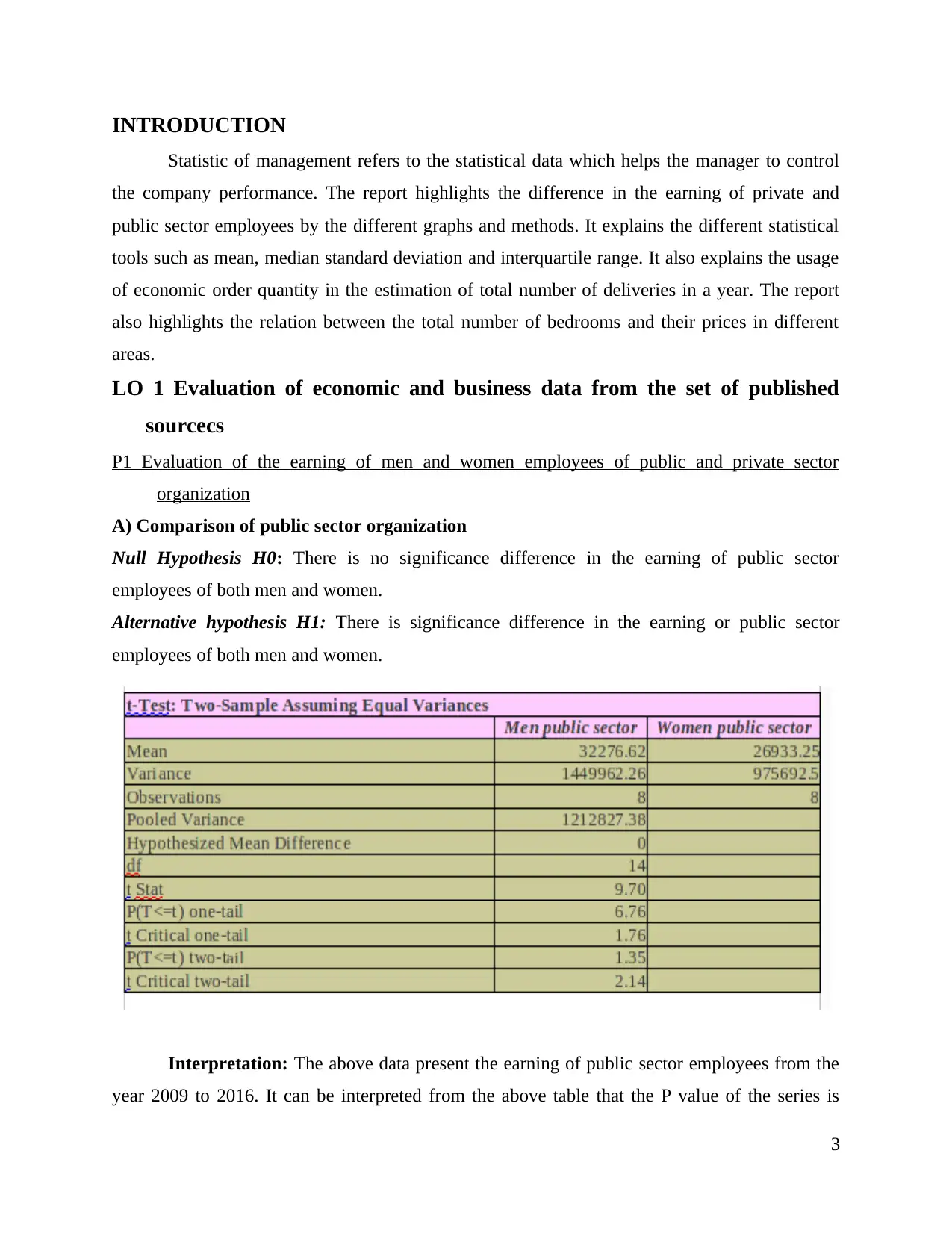
INTRODUCTION
Statistic of management refers to the statistical data which helps the manager to control
the company performance. The report highlights the difference in the earning of private and
public sector employees by the different graphs and methods. It explains the different statistical
tools such as mean, median standard deviation and interquartile range. It also explains the usage
of economic order quantity in the estimation of total number of deliveries in a year. The report
also highlights the relation between the total number of bedrooms and their prices in different
areas.
LO 1 Evaluation of economic and business data from the set of published
sourcecs
P1 Evaluation of the earning of men and women employees of public and private sector
organization
A) Comparison of public sector organization
Null Hypothesis H0: There is no significance difference in the earning of public sector
employees of both men and women.
Alternative hypothesis H1: There is significance difference in the earning or public sector
employees of both men and women.
Interpretation: The above data present the earning of public sector employees from the
year 2009 to 2016. It can be interpreted from the above table that the P value of the series is
3
Statistic of management refers to the statistical data which helps the manager to control
the company performance. The report highlights the difference in the earning of private and
public sector employees by the different graphs and methods. It explains the different statistical
tools such as mean, median standard deviation and interquartile range. It also explains the usage
of economic order quantity in the estimation of total number of deliveries in a year. The report
also highlights the relation between the total number of bedrooms and their prices in different
areas.
LO 1 Evaluation of economic and business data from the set of published
sourcecs
P1 Evaluation of the earning of men and women employees of public and private sector
organization
A) Comparison of public sector organization
Null Hypothesis H0: There is no significance difference in the earning of public sector
employees of both men and women.
Alternative hypothesis H1: There is significance difference in the earning or public sector
employees of both men and women.
Interpretation: The above data present the earning of public sector employees from the
year 2009 to 2016. It can be interpreted from the above table that the P value of the series is
3
⊘ This is a preview!⊘
Do you want full access?
Subscribe today to unlock all pages.

Trusted by 1+ million students worldwide
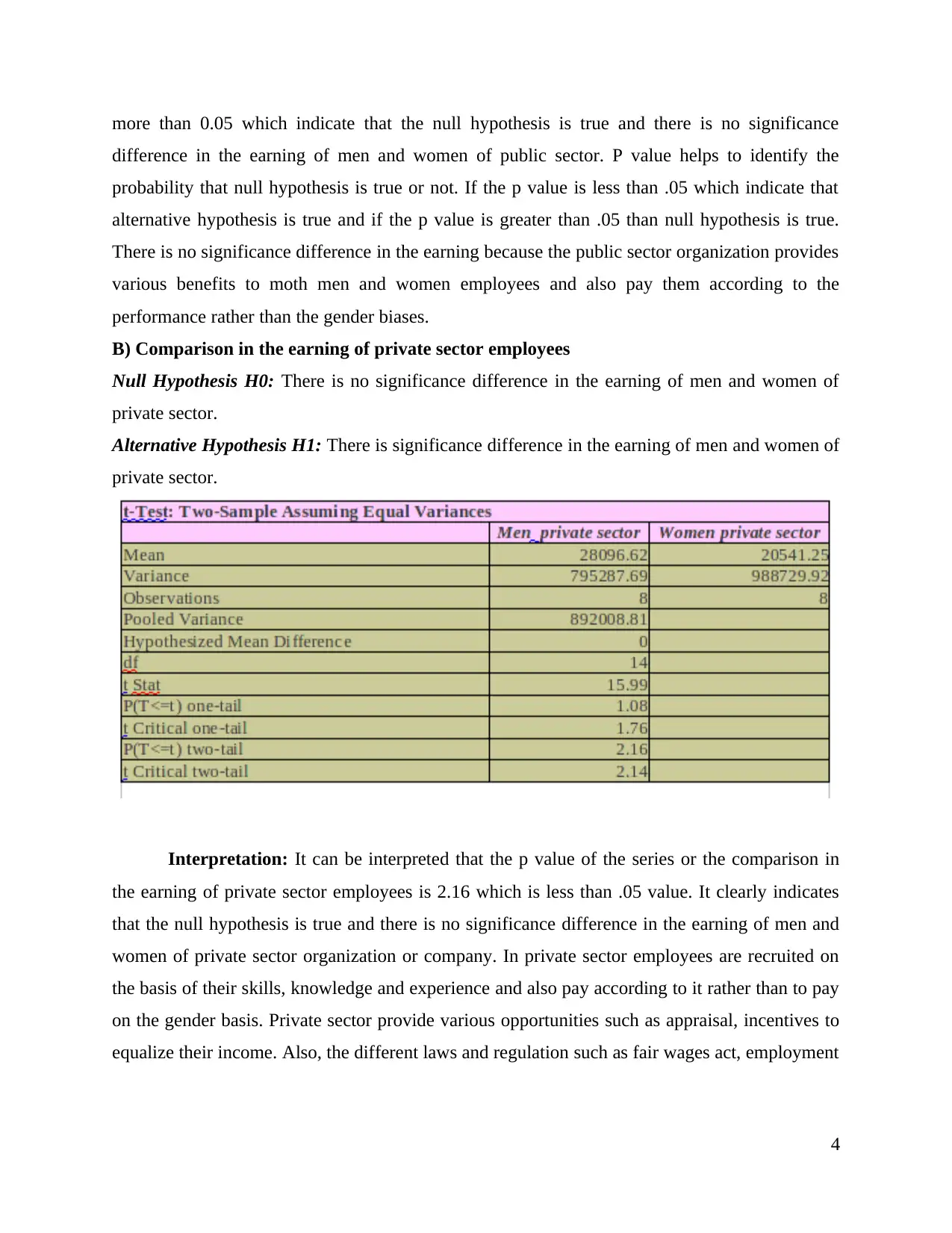
more than 0.05 which indicate that the null hypothesis is true and there is no significance
difference in the earning of men and women of public sector. P value helps to identify the
probability that null hypothesis is true or not. If the p value is less than .05 which indicate that
alternative hypothesis is true and if the p value is greater than .05 than null hypothesis is true.
There is no significance difference in the earning because the public sector organization provides
various benefits to moth men and women employees and also pay them according to the
performance rather than the gender biases.
B) Comparison in the earning of private sector employees
Null Hypothesis H0: There is no significance difference in the earning of men and women of
private sector.
Alternative Hypothesis H1: There is significance difference in the earning of men and women of
private sector.
Interpretation: It can be interpreted that the p value of the series or the comparison in
the earning of private sector employees is 2.16 which is less than .05 value. It clearly indicates
that the null hypothesis is true and there is no significance difference in the earning of men and
women of private sector organization or company. In private sector employees are recruited on
the basis of their skills, knowledge and experience and also pay according to it rather than to pay
on the gender basis. Private sector provide various opportunities such as appraisal, incentives to
equalize their income. Also, the different laws and regulation such as fair wages act, employment
4
difference in the earning of men and women of public sector. P value helps to identify the
probability that null hypothesis is true or not. If the p value is less than .05 which indicate that
alternative hypothesis is true and if the p value is greater than .05 than null hypothesis is true.
There is no significance difference in the earning because the public sector organization provides
various benefits to moth men and women employees and also pay them according to the
performance rather than the gender biases.
B) Comparison in the earning of private sector employees
Null Hypothesis H0: There is no significance difference in the earning of men and women of
private sector.
Alternative Hypothesis H1: There is significance difference in the earning of men and women of
private sector.
Interpretation: It can be interpreted that the p value of the series or the comparison in
the earning of private sector employees is 2.16 which is less than .05 value. It clearly indicates
that the null hypothesis is true and there is no significance difference in the earning of men and
women of private sector organization or company. In private sector employees are recruited on
the basis of their skills, knowledge and experience and also pay according to it rather than to pay
on the gender basis. Private sector provide various opportunities such as appraisal, incentives to
equalize their income. Also, the different laws and regulation such as fair wages act, employment
4
Paraphrase This Document
Need a fresh take? Get an instant paraphrase of this document with our AI Paraphraser
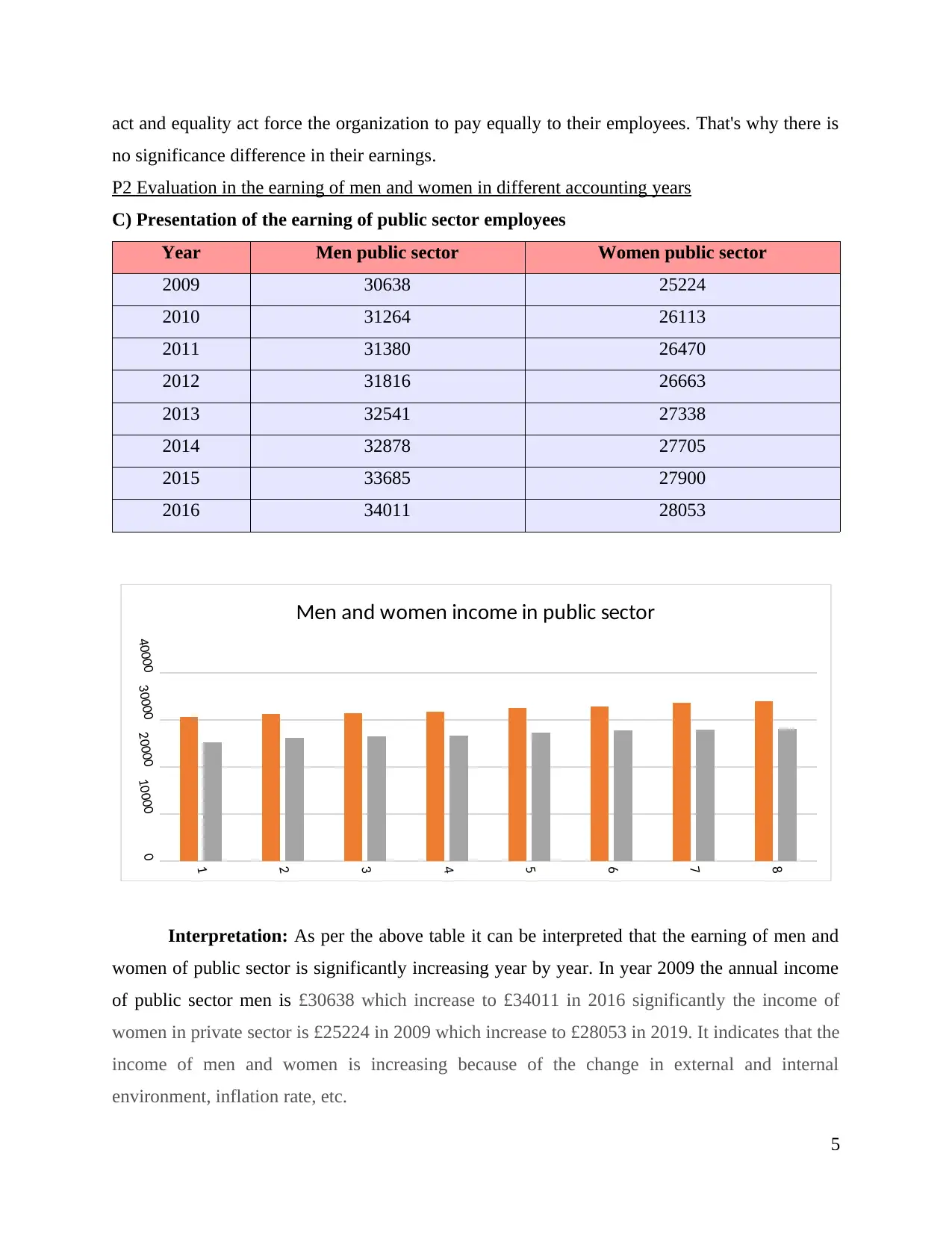
act and equality act force the organization to pay equally to their employees. That's why there is
no significance difference in their earnings.
P2 Evaluation in the earning of men and women in different accounting years
C) Presentation of the earning of public sector employees
Year Men public sector Women public sector
2009 30638 25224
2010 31264 26113
2011 31380 26470
2012 31816 26663
2013 32541 27338
2014 32878 27705
2015 33685 27900
2016 34011 28053
Interpretation: As per the above table it can be interpreted that the earning of men and
women of public sector is significantly increasing year by year. In year 2009 the annual income
of public sector men is £30638 which increase to £34011 in 2016 significantly the income of
women in private sector is £25224 in 2009 which increase to £28053 in 2019. It indicates that the
income of men and women is increasing because of the change in external and internal
environment, inflation rate, etc.
5
1
2
3
4
5
6
7
8
0
10000
20000
30000
40000
Men and women income in public sector
no significance difference in their earnings.
P2 Evaluation in the earning of men and women in different accounting years
C) Presentation of the earning of public sector employees
Year Men public sector Women public sector
2009 30638 25224
2010 31264 26113
2011 31380 26470
2012 31816 26663
2013 32541 27338
2014 32878 27705
2015 33685 27900
2016 34011 28053
Interpretation: As per the above table it can be interpreted that the earning of men and
women of public sector is significantly increasing year by year. In year 2009 the annual income
of public sector men is £30638 which increase to £34011 in 2016 significantly the income of
women in private sector is £25224 in 2009 which increase to £28053 in 2019. It indicates that the
income of men and women is increasing because of the change in external and internal
environment, inflation rate, etc.
5
1
2
3
4
5
6
7
8
0
10000
20000
30000
40000
Men and women income in public sector
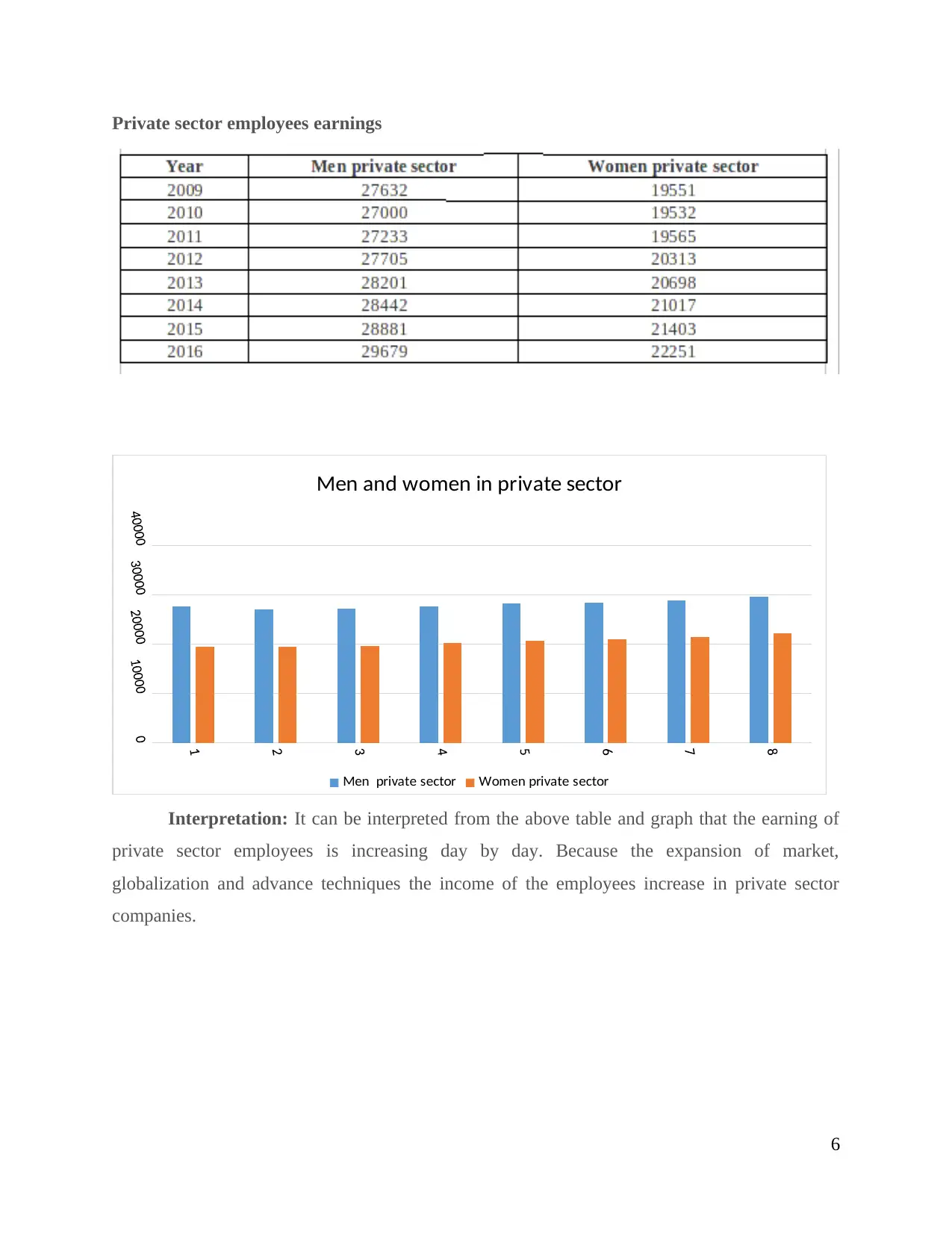
Private sector employees earnings
Men and women in private sector
Men private sector Women private sector
Interpretation: It can be interpreted from the above table and graph that the earning of
private sector employees is increasing day by day. Because the expansion of market,
globalization and advance techniques the income of the employees increase in private sector
companies.
6
Men and women in private sector
Men private sector Women private sector
Interpretation: It can be interpreted from the above table and graph that the earning of
private sector employees is increasing day by day. Because the expansion of market,
globalization and advance techniques the income of the employees increase in private sector
companies.
6
⊘ This is a preview!⊘
Do you want full access?
Subscribe today to unlock all pages.

Trusted by 1+ million students worldwide
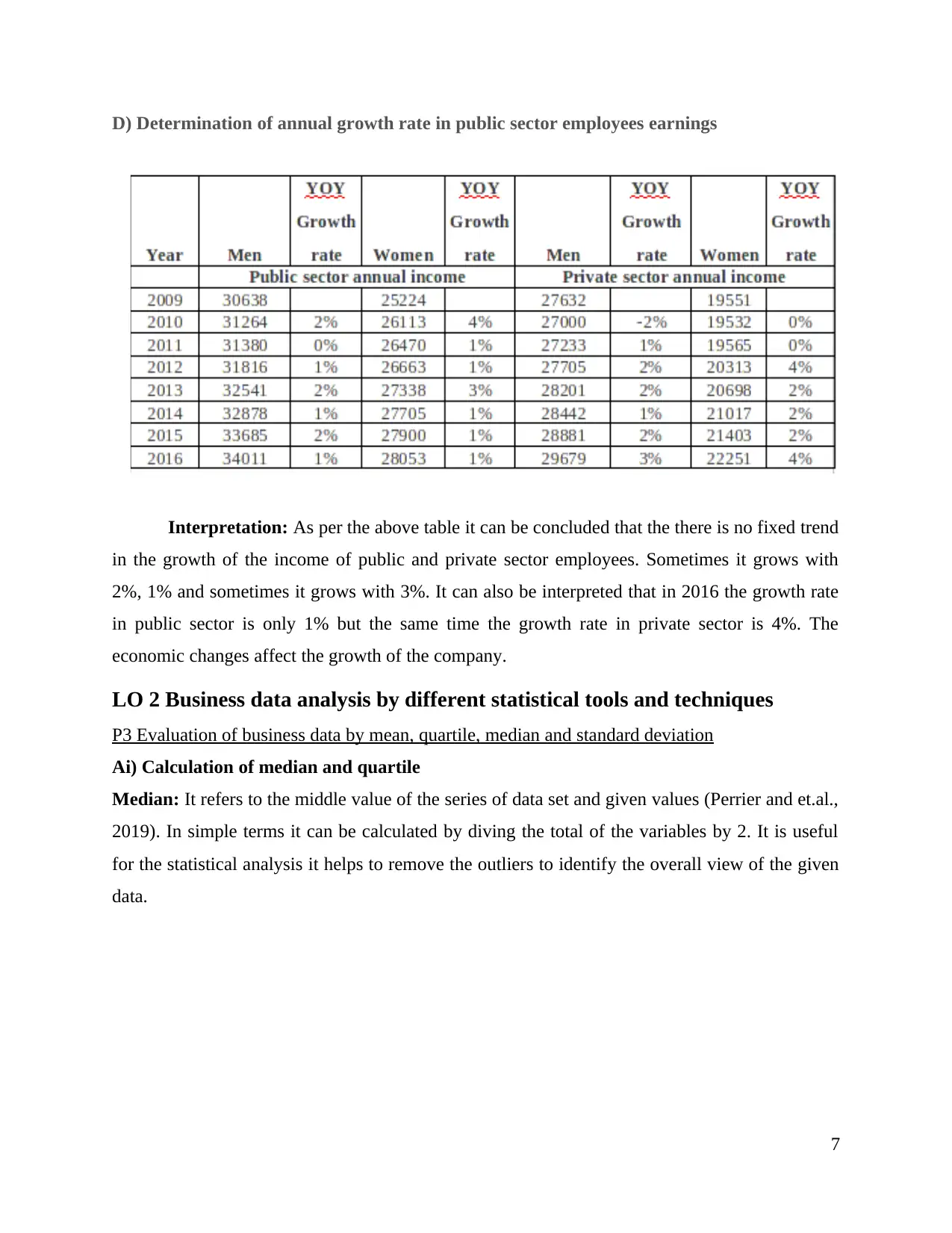
D) Determination of annual growth rate in public sector employees earnings
Interpretation: As per the above table it can be concluded that the there is no fixed trend
in the growth of the income of public and private sector employees. Sometimes it grows with
2%, 1% and sometimes it grows with 3%. It can also be interpreted that in 2016 the growth rate
in public sector is only 1% but the same time the growth rate in private sector is 4%. The
economic changes affect the growth of the company.
LO 2 Business data analysis by different statistical tools and techniques
P3 Evaluation of business data by mean, quartile, median and standard deviation
Ai) Calculation of median and quartile
Median: It refers to the middle value of the series of data set and given values (Perrier and et.al.,
2019). In simple terms it can be calculated by diving the total of the variables by 2. It is useful
for the statistical analysis it helps to remove the outliers to identify the overall view of the given
data.
7
Interpretation: As per the above table it can be concluded that the there is no fixed trend
in the growth of the income of public and private sector employees. Sometimes it grows with
2%, 1% and sometimes it grows with 3%. It can also be interpreted that in 2016 the growth rate
in public sector is only 1% but the same time the growth rate in private sector is 4%. The
economic changes affect the growth of the company.
LO 2 Business data analysis by different statistical tools and techniques
P3 Evaluation of business data by mean, quartile, median and standard deviation
Ai) Calculation of median and quartile
Median: It refers to the middle value of the series of data set and given values (Perrier and et.al.,
2019). In simple terms it can be calculated by diving the total of the variables by 2. It is useful
for the statistical analysis it helps to remove the outliers to identify the overall view of the given
data.
7
Paraphrase This Document
Need a fresh take? Get an instant paraphrase of this document with our AI Paraphraser
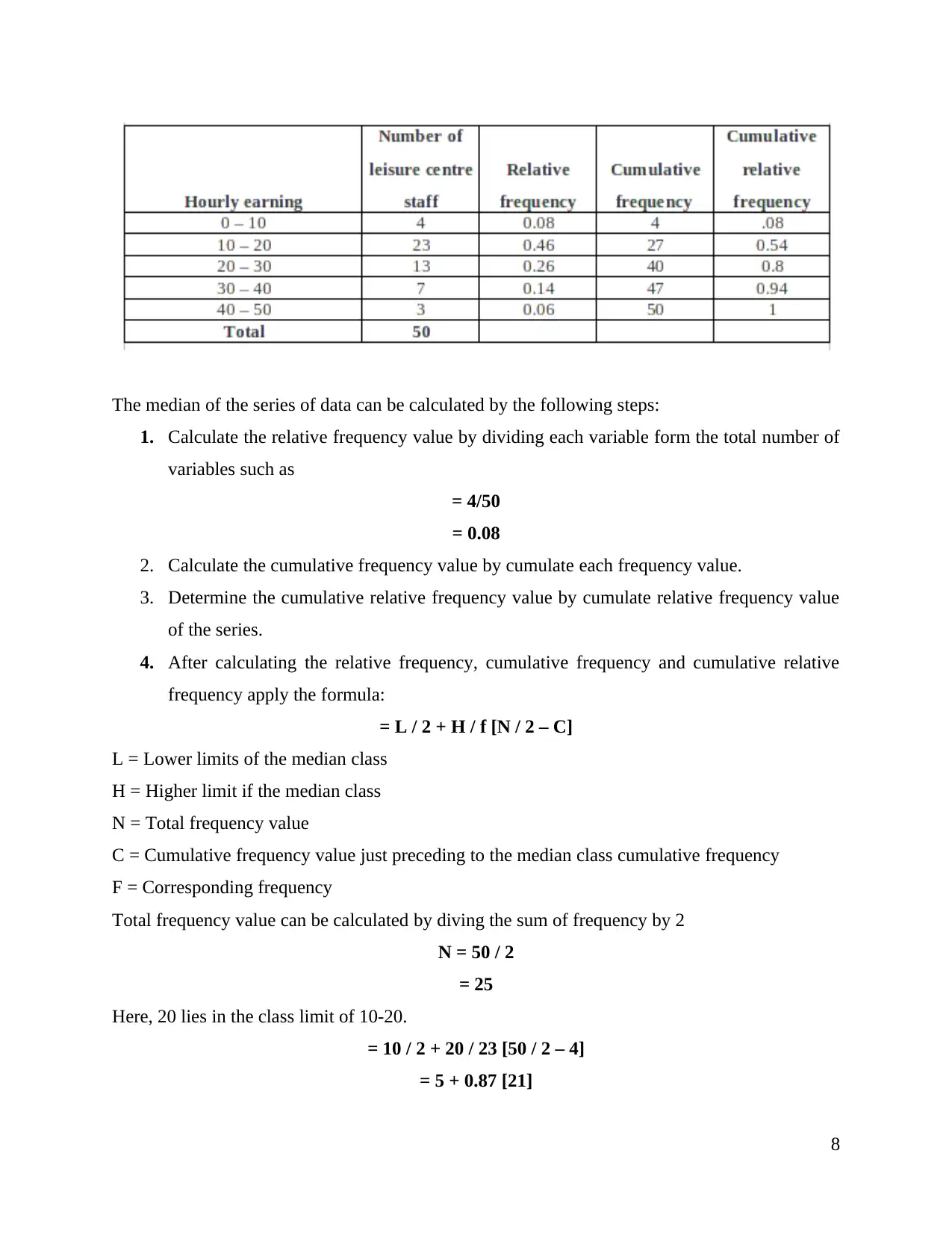
The median of the series of data can be calculated by the following steps:
1. Calculate the relative frequency value by dividing each variable form the total number of
variables such as
= 4/50
= 0.08
2. Calculate the cumulative frequency value by cumulate each frequency value.
3. Determine the cumulative relative frequency value by cumulate relative frequency value
of the series.
4. After calculating the relative frequency, cumulative frequency and cumulative relative
frequency apply the formula:
= L / 2 + H / f [N / 2 – C]
L = Lower limits of the median class
H = Higher limit if the median class
N = Total frequency value
C = Cumulative frequency value just preceding to the median class cumulative frequency
F = Corresponding frequency
Total frequency value can be calculated by diving the sum of frequency by 2
N = 50 / 2
= 25
Here, 20 lies in the class limit of 10-20.
= 10 / 2 + 20 / 23 [50 / 2 – 4]
= 5 + 0.87 [21]
8
1. Calculate the relative frequency value by dividing each variable form the total number of
variables such as
= 4/50
= 0.08
2. Calculate the cumulative frequency value by cumulate each frequency value.
3. Determine the cumulative relative frequency value by cumulate relative frequency value
of the series.
4. After calculating the relative frequency, cumulative frequency and cumulative relative
frequency apply the formula:
= L / 2 + H / f [N / 2 – C]
L = Lower limits of the median class
H = Higher limit if the median class
N = Total frequency value
C = Cumulative frequency value just preceding to the median class cumulative frequency
F = Corresponding frequency
Total frequency value can be calculated by diving the sum of frequency by 2
N = 50 / 2
= 25
Here, 20 lies in the class limit of 10-20.
= 10 / 2 + 20 / 23 [50 / 2 – 4]
= 5 + 0.87 [21]
8
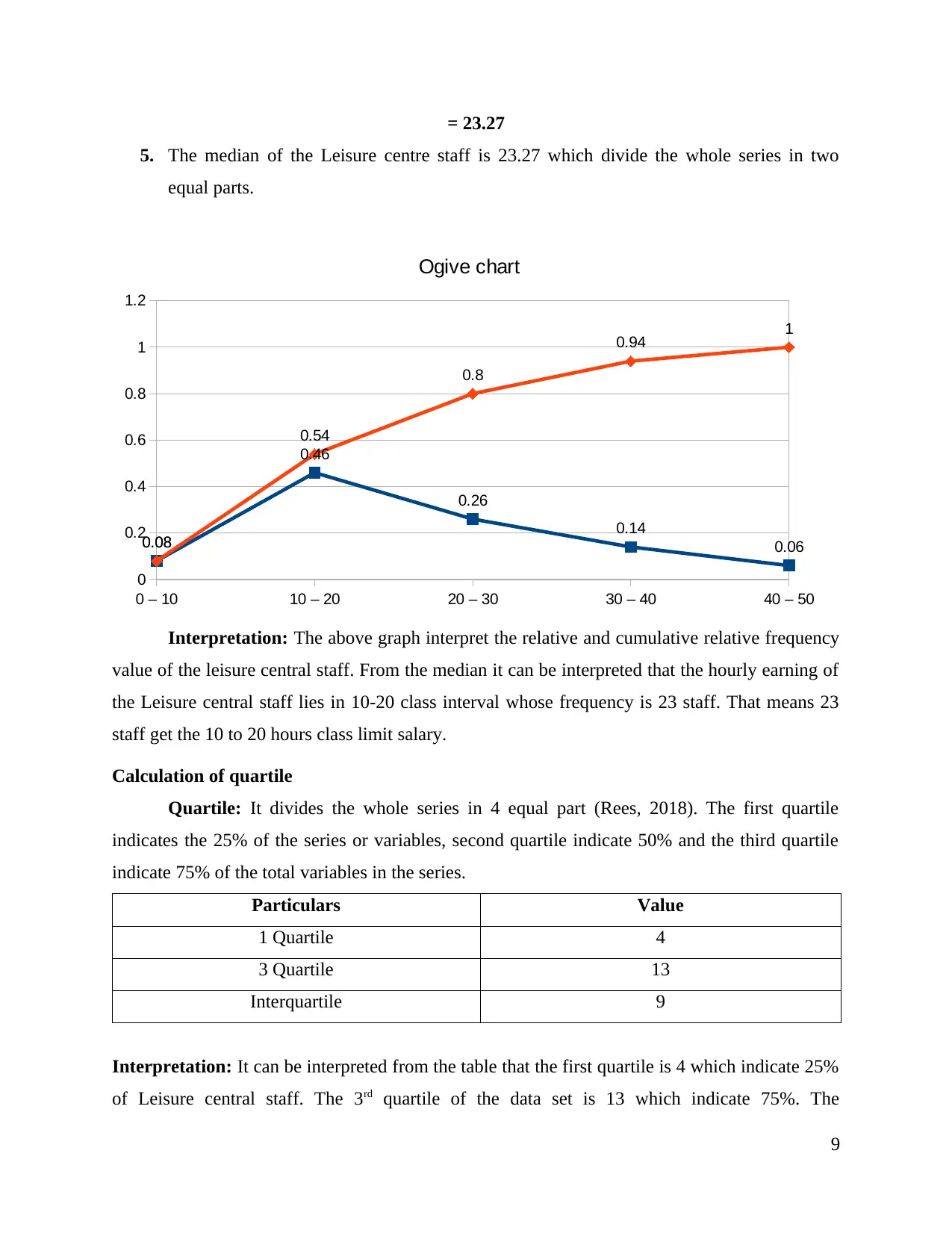
= 23.27
5. The median of the Leisure centre staff is 23.27 which divide the whole series in two
equal parts.
Interpretation: The above graph interpret the relative and cumulative relative frequency
value of the leisure central staff. From the median it can be interpreted that the hourly earning of
the Leisure central staff lies in 10-20 class interval whose frequency is 23 staff. That means 23
staff get the 10 to 20 hours class limit salary.
Calculation of quartile
Quartile: It divides the whole series in 4 equal part (Rees, 2018). The first quartile
indicates the 25% of the series or variables, second quartile indicate 50% and the third quartile
indicate 75% of the total variables in the series.
Particulars Value
1 Quartile 4
3 Quartile 13
Interquartile 9
Interpretation: It can be interpreted from the table that the first quartile is 4 which indicate 25%
of Leisure central staff. The 3rd quartile of the data set is 13 which indicate 75%. The
9
0 – 10 10 – 20 20 – 30 30 – 40 40 – 50
0
0.2
0.4
0.6
0.8
1
1.2
0.08
0.46
0.26
0.14
0.060.08
0.54
0.8
0.94 1
Ogive chart
5. The median of the Leisure centre staff is 23.27 which divide the whole series in two
equal parts.
Interpretation: The above graph interpret the relative and cumulative relative frequency
value of the leisure central staff. From the median it can be interpreted that the hourly earning of
the Leisure central staff lies in 10-20 class interval whose frequency is 23 staff. That means 23
staff get the 10 to 20 hours class limit salary.
Calculation of quartile
Quartile: It divides the whole series in 4 equal part (Rees, 2018). The first quartile
indicates the 25% of the series or variables, second quartile indicate 50% and the third quartile
indicate 75% of the total variables in the series.
Particulars Value
1 Quartile 4
3 Quartile 13
Interquartile 9
Interpretation: It can be interpreted from the table that the first quartile is 4 which indicate 25%
of Leisure central staff. The 3rd quartile of the data set is 13 which indicate 75%. The
9
0 – 10 10 – 20 20 – 30 30 – 40 40 – 50
0
0.2
0.4
0.6
0.8
1
1.2
0.08
0.46
0.26
0.14
0.060.08
0.54
0.8
0.94 1
Ogive chart
⊘ This is a preview!⊘
Do you want full access?
Subscribe today to unlock all pages.

Trusted by 1+ million students worldwide
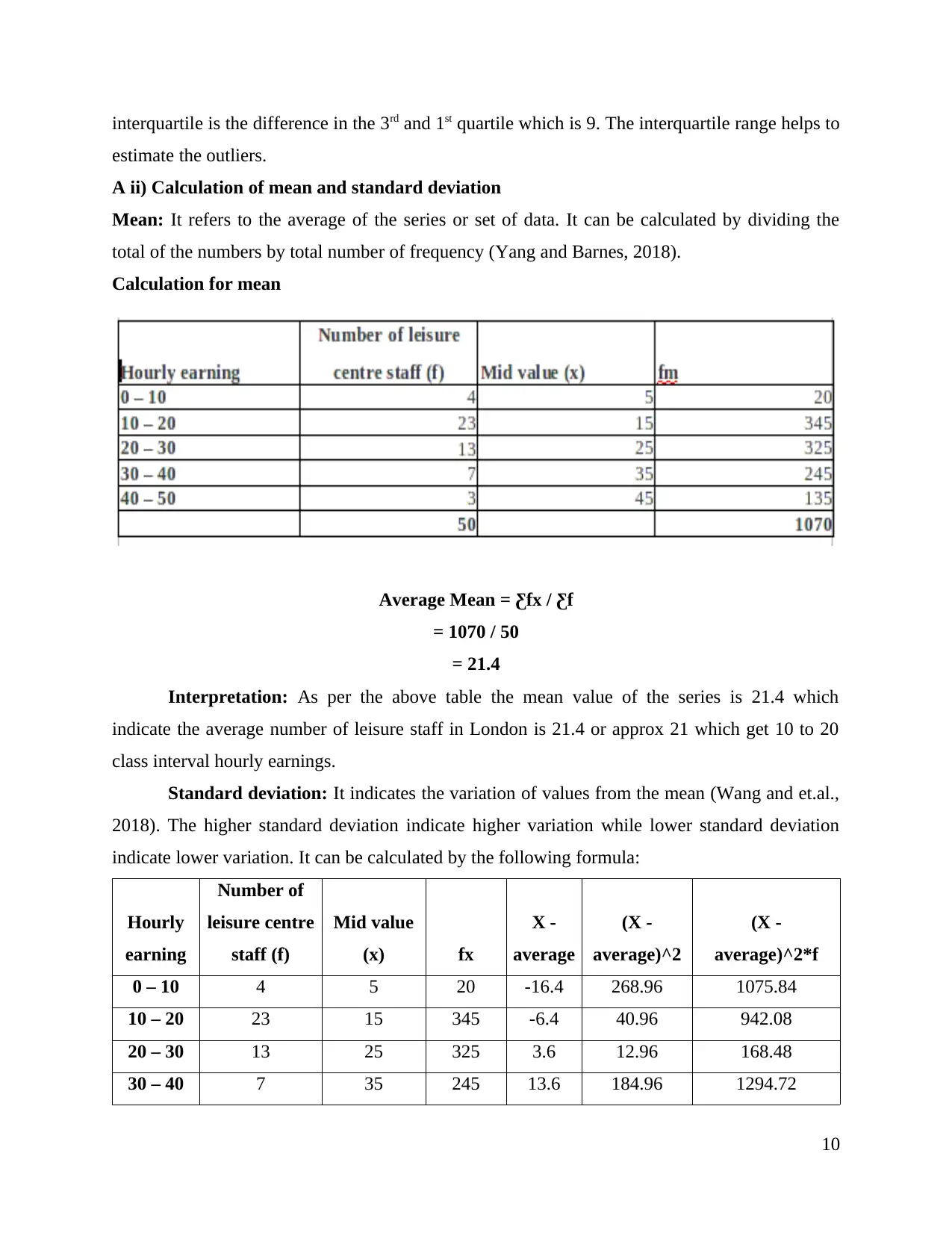
interquartile is the difference in the 3rd and 1st quartile which is 9. The interquartile range helps to
estimate the outliers.
A ii) Calculation of mean and standard deviation
Mean: It refers to the average of the series or set of data. It can be calculated by dividing the
total of the numbers by total number of frequency (Yang and Barnes, 2018).
Calculation for mean
Average Mean = Ƹfx / Ƹf
= 1070 / 50
= 21.4
Interpretation: As per the above table the mean value of the series is 21.4 which
indicate the average number of leisure staff in London is 21.4 or approx 21 which get 10 to 20
class interval hourly earnings.
Standard deviation: It indicates the variation of values from the mean (Wang and et.al.,
2018). The higher standard deviation indicate higher variation while lower standard deviation
indicate lower variation. It can be calculated by the following formula:
Hourly
earning
Number of
leisure centre
staff (f)
Mid value
(x) fx
X -
average
(X -
average)^2
(X -
average)^2*f
0 – 10 4 5 20 -16.4 268.96 1075.84
10 – 20 23 15 345 -6.4 40.96 942.08
20 – 30 13 25 325 3.6 12.96 168.48
30 – 40 7 35 245 13.6 184.96 1294.72
10
estimate the outliers.
A ii) Calculation of mean and standard deviation
Mean: It refers to the average of the series or set of data. It can be calculated by dividing the
total of the numbers by total number of frequency (Yang and Barnes, 2018).
Calculation for mean
Average Mean = Ƹfx / Ƹf
= 1070 / 50
= 21.4
Interpretation: As per the above table the mean value of the series is 21.4 which
indicate the average number of leisure staff in London is 21.4 or approx 21 which get 10 to 20
class interval hourly earnings.
Standard deviation: It indicates the variation of values from the mean (Wang and et.al.,
2018). The higher standard deviation indicate higher variation while lower standard deviation
indicate lower variation. It can be calculated by the following formula:
Hourly
earning
Number of
leisure centre
staff (f)
Mid value
(x) fx
X -
average
(X -
average)^2
(X -
average)^2*f
0 – 10 4 5 20 -16.4 268.96 1075.84
10 – 20 23 15 345 -6.4 40.96 942.08
20 – 30 13 25 325 3.6 12.96 168.48
30 – 40 7 35 245 13.6 184.96 1294.72
10
Paraphrase This Document
Need a fresh take? Get an instant paraphrase of this document with our AI Paraphraser
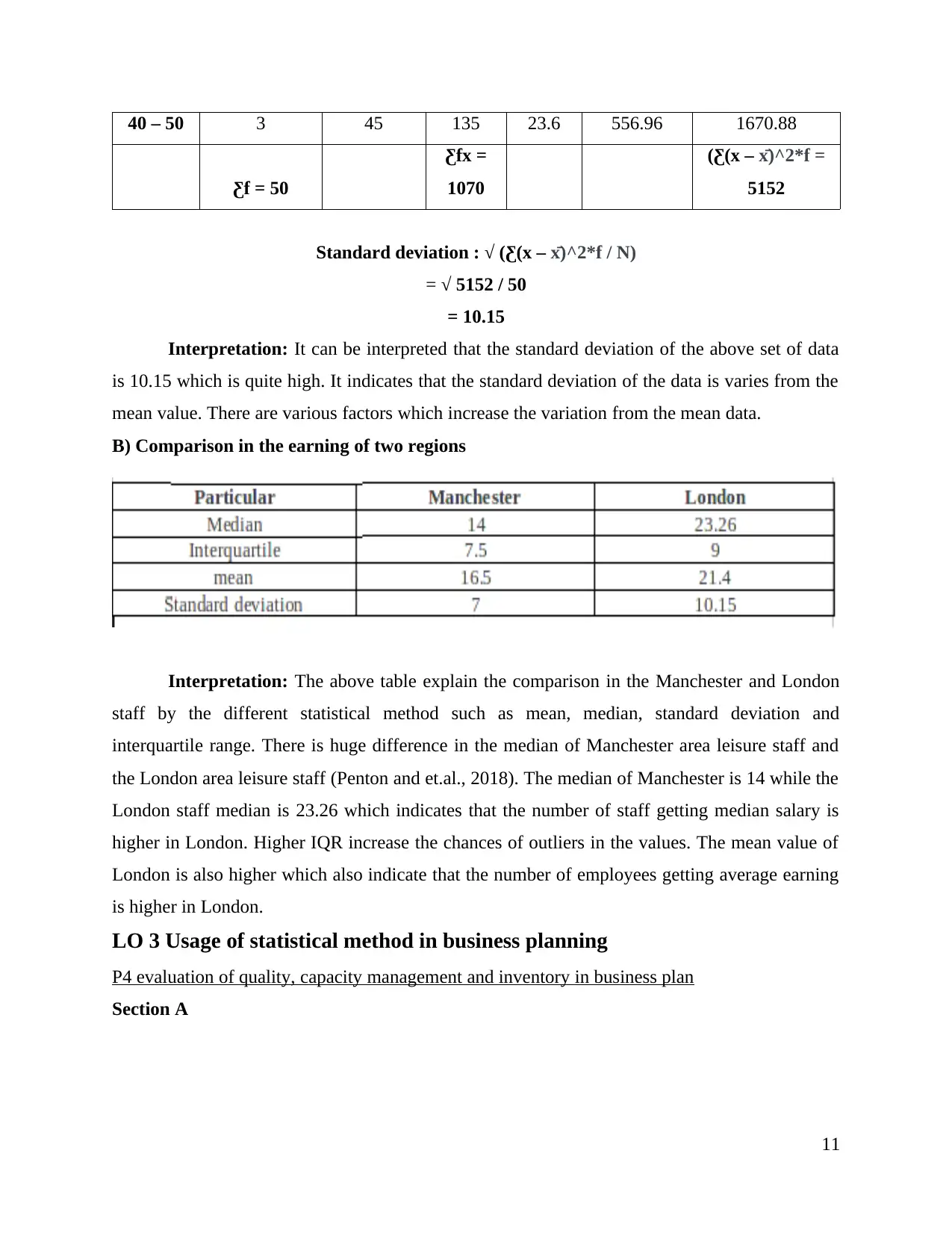
40 – 50 3 45 135 23.6 556.96 1670.88
Ƹf = 50
Ƹfx =
1070
(Ƹ(x – x̄)^2*f =
5152
Standard deviation : √ (Ƹ(x – x̄)^2*f / N)
= √ 5152 / 50
= 10.15
Interpretation: It can be interpreted that the standard deviation of the above set of data
is 10.15 which is quite high. It indicates that the standard deviation of the data is varies from the
mean value. There are various factors which increase the variation from the mean data.
B) Comparison in the earning of two regions
Interpretation: The above table explain the comparison in the Manchester and London
staff by the different statistical method such as mean, median, standard deviation and
interquartile range. There is huge difference in the median of Manchester area leisure staff and
the London area leisure staff (Penton and et.al., 2018). The median of Manchester is 14 while the
London staff median is 23.26 which indicates that the number of staff getting median salary is
higher in London. Higher IQR increase the chances of outliers in the values. The mean value of
London is also higher which also indicate that the number of employees getting average earning
is higher in London.
LO 3 Usage of statistical method in business planning
P4 evaluation of quality, capacity management and inventory in business plan
Section A
11
Ƹf = 50
Ƹfx =
1070
(Ƹ(x – x̄)^2*f =
5152
Standard deviation : √ (Ƹ(x – x̄)^2*f / N)
= √ 5152 / 50
= 10.15
Interpretation: It can be interpreted that the standard deviation of the above set of data
is 10.15 which is quite high. It indicates that the standard deviation of the data is varies from the
mean value. There are various factors which increase the variation from the mean data.
B) Comparison in the earning of two regions
Interpretation: The above table explain the comparison in the Manchester and London
staff by the different statistical method such as mean, median, standard deviation and
interquartile range. There is huge difference in the median of Manchester area leisure staff and
the London area leisure staff (Penton and et.al., 2018). The median of Manchester is 14 while the
London staff median is 23.26 which indicates that the number of staff getting median salary is
higher in London. Higher IQR increase the chances of outliers in the values. The mean value of
London is also higher which also indicate that the number of employees getting average earning
is higher in London.
LO 3 Usage of statistical method in business planning
P4 evaluation of quality, capacity management and inventory in business plan
Section A
11
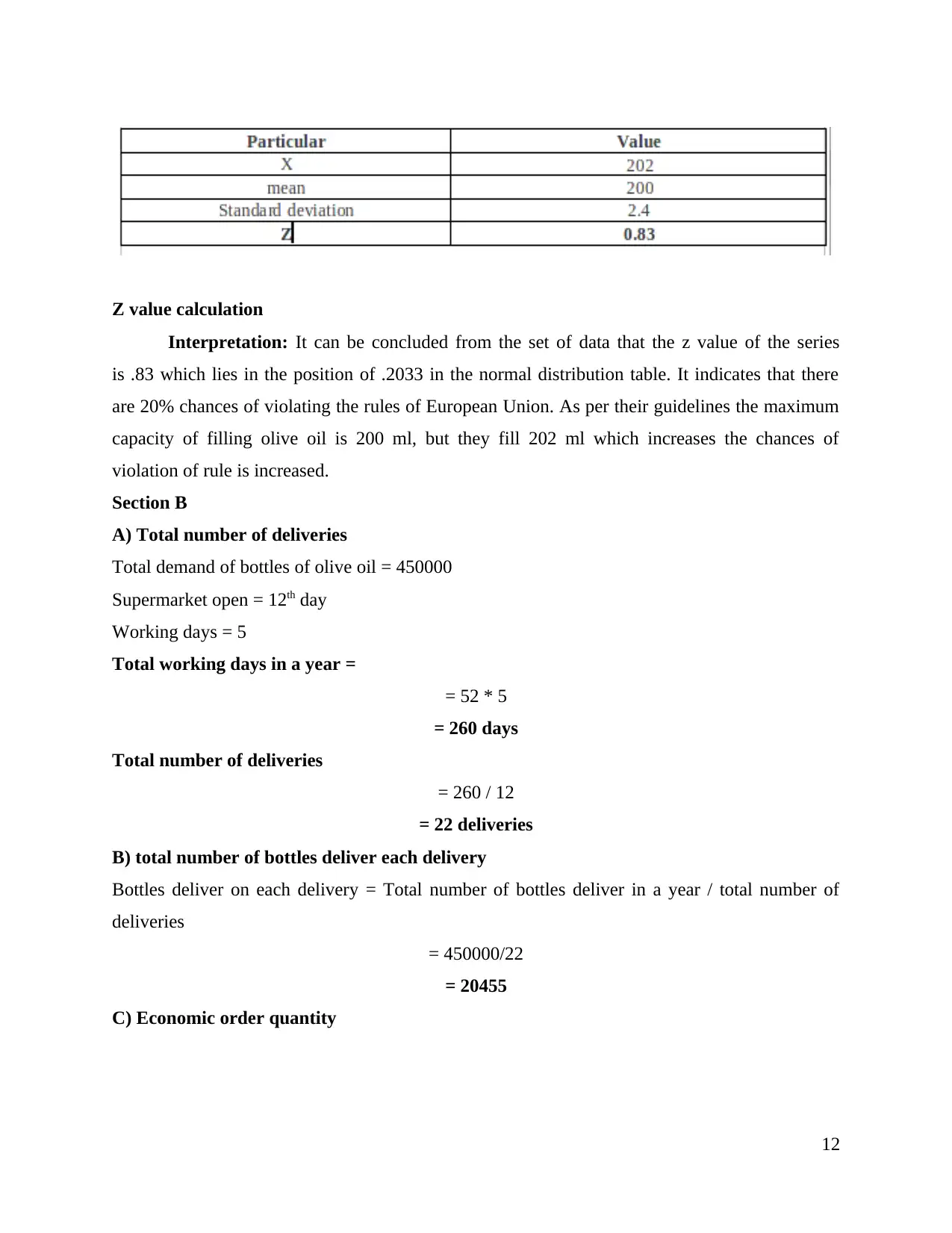
Z value calculation
Interpretation: It can be concluded from the set of data that the z value of the series
is .83 which lies in the position of .2033 in the normal distribution table. It indicates that there
are 20% chances of violating the rules of European Union. As per their guidelines the maximum
capacity of filling olive oil is 200 ml, but they fill 202 ml which increases the chances of
violation of rule is increased.
Section B
A) Total number of deliveries
Total demand of bottles of olive oil = 450000
Supermarket open = 12th day
Working days = 5
Total working days in a year =
= 52 * 5
= 260 days
Total number of deliveries
= 260 / 12
= 22 deliveries
B) total number of bottles deliver each delivery
Bottles deliver on each delivery = Total number of bottles deliver in a year / total number of
deliveries
= 450000/22
= 20455
C) Economic order quantity
12
Interpretation: It can be concluded from the set of data that the z value of the series
is .83 which lies in the position of .2033 in the normal distribution table. It indicates that there
are 20% chances of violating the rules of European Union. As per their guidelines the maximum
capacity of filling olive oil is 200 ml, but they fill 202 ml which increases the chances of
violation of rule is increased.
Section B
A) Total number of deliveries
Total demand of bottles of olive oil = 450000
Supermarket open = 12th day
Working days = 5
Total working days in a year =
= 52 * 5
= 260 days
Total number of deliveries
= 260 / 12
= 22 deliveries
B) total number of bottles deliver each delivery
Bottles deliver on each delivery = Total number of bottles deliver in a year / total number of
deliveries
= 450000/22
= 20455
C) Economic order quantity
12
⊘ This is a preview!⊘
Do you want full access?
Subscribe today to unlock all pages.

Trusted by 1+ million students worldwide
1 out of 19
Related Documents
Your All-in-One AI-Powered Toolkit for Academic Success.
+13062052269
info@desklib.com
Available 24*7 on WhatsApp / Email
![[object Object]](/_next/static/media/star-bottom.7253800d.svg)
Unlock your academic potential
Copyright © 2020–2025 A2Z Services. All Rights Reserved. Developed and managed by ZUCOL.





